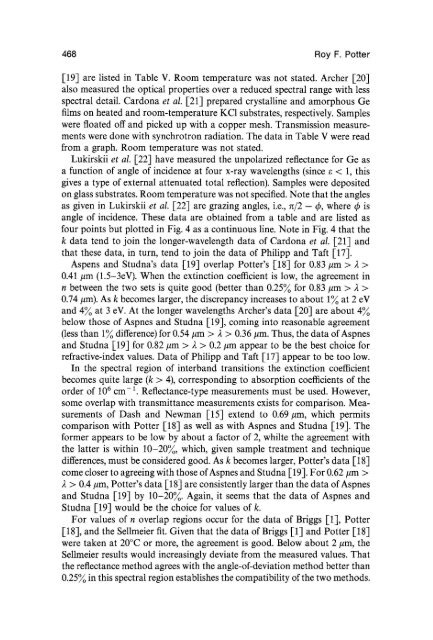Gallium Arsenide (GaAs) - Courses
Gallium Arsenide (GaAs) - Courses
Gallium Arsenide (GaAs) - Courses
Create successful ePaper yourself
Turn your PDF publications into a flip-book with our unique Google optimized e-Paper software.
468 Roy F. Potter<br />
[19] are listed in Table V. Room temperature was not stated. Archer [20]<br />
also measured the optical properties over a reduced spectral range with less<br />
spectral detail. Cardona et al. [21] prepared crystalline and amorphous Ge<br />
films on heated and room-temperature KCI substrates, respectively. Samples<br />
were floated off and picked up with a copper mesh. Transmission measurements<br />
were done with synchrotron radiation. The data in Table V were read<br />
from a graph. Room temperature was not stated.<br />
Lukirskii et al. [22] have measured the unpolarized reflectance for Ge as<br />
a function of angle of incidence at four x-ray wavelengths (since e < 1, this<br />
gives a type of external attenuated total reflection). Samples were deposited<br />
on glass substrates. Room temperature was not specified. Note that the angles<br />
as given in Lukirskii et al. [22] are grazing angles, i.e., nl2 - <br />
0.41 flm (1.5-3eV). When the extinction coefficient is low, the agreement in<br />
n between the two sets is quite good (better than 0.25% for 0.83 flm > A ><br />
0.74 flm). As k becomes larger, the discrepancy increases to about 1% at 2 eV<br />
and 4% at 3 eV. At the longer wavelengths Archer's data [20] are about 4%<br />
below those of Aspnes and Studna [19], coming into reasonable agreement<br />
(less than 1% difference) for 0.54 flm > A > 0.36 flm. Thus, the data of Aspnes<br />
and Studna [19] for 0.82 flm > A > 0.2 flm appear to be the best choice for<br />
refractive-index values. Data of Philipp and Taft [17] appear to be too low.<br />
In the spectral region of interband transitions the extinction coefficient<br />
becomes quite large (k > 4), corresponding to absorption coefficients of the<br />
order of 10 6 cm - 1. Reflectance-type measurements must be used. However,<br />
some overlap with transmittance measurements exists for comparison. Measurements<br />
of Dash and Newman [15] extend to 0.69 flm, which permits<br />
comparison with Potter [18J as well as with Aspnes and Studna [19]. The<br />
former appears to be low by about a factor of 2, whilte the agreement with<br />
the latter is within 10-20%, which, given sample treatment and technique<br />
differences, must be considered good. As k becomes larger, Potter's data [18J<br />
come closer to agreeing with those of Aspnes and Studna [19]. For 0.62 flm ><br />
A> 0.4 flm, Potter's data [18J are consistently larger than the data of Aspnes<br />
and Studna [19J by 10-20%. Again, it seems that the data of Aspnes and<br />
Studna [19J would be the choice for values of k.<br />
For values of n overlap regions occur for the data of Briggs [1], Potter<br />
[18J, and the Sellmeier fit. Given that the data of Briggs [lJ and Potter [18]<br />
were taken at 20°C or more, the agreement is good. Below about 2 flm, the<br />
Sellmeier results would increasingly deviate from the measured values. That<br />
the reflectance method agrees with the angle-of-deviation method better than<br />
0.25% in this spectral region establishes the compatibility of the two methods.
















